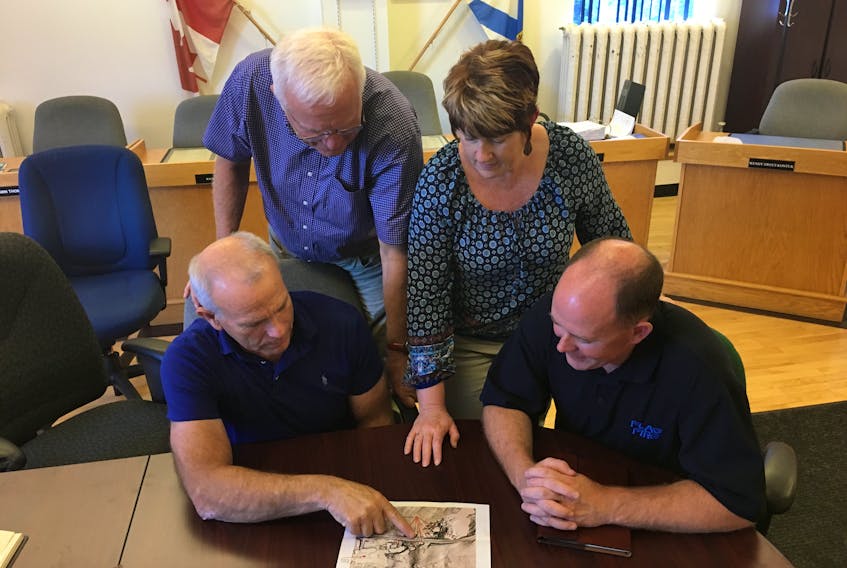OXFORD, N.S. — Calls are continuing for the provincial Transportation and Infrastructure Renewal Department to take the lead in a joint study of the integrity of the Trans-Canada Highway near Oxford.
“We want to continue raising the issue,” Cumberland-Colchester MP Bill Casey said. “This is an important highway connecting Oxford and Nova Scotia to the rest of Canada. There is no alternative should something happen.”
Casey was joined by Cumberland South MLA Tory Rushton, Cumberland EMO co-ordinator Mike Johnson and Oxford CAO Rachel Jones in renewing their calls for TIR to come to the table to complete a study in concert with Transport Canada to determine whether there is any sinkhole development under the highway.
“GHD said there is a high probably of the development of sinkholes and recommended the highway be investigated,” Casey said. “We’re hearing all kinds of anecdotal evidence of sinkhole activity in the area over the years.”
He said local officials are simply asking the province to reconsider and have a look to reassure people the highway is stable.
“In the end, I believe common sense will prevail,” he said. Common sense always prevails.”
Last week, Casey urged the provincial and federal transportation ministers to work together to co-fund a study of Highway 104 and Highway 321 as recommended by GHD, which did a geotechnical study of the sinkhole that has closed the Lions Park in Oxford.
Nova Scotia’s Transportation and Infrastructure Minister Lloyd Hines said the highway is monitored regularly and said the LIDAR information hasn’t been analyzed as of yet, but would be quick to act if required.
Johnson said uncertainty with the highway is disconcerting to the community and he feels it defies logic to not at least do some testing of what’s going on underground.
“You don’t have to be a geologist to arrive at an opinion of what’s going on and looking at the LIDAR mapping available to us certainly is consistent with the report by GHD that there’s a lot of activity in the area,” Johnson said.
GHD, he said, tested a small area of karst topography around the Lions Park in Oxford. It stands to reason to say the area tested is very similar in its topography to a much larger area.
“Whatever we find in this small area is fairly consistent with what’s going to be in this larger area. Most of the area is uninhabited, but a small area of it has several thousand vehicles going over top of it every day,” Johnson said. “That’s where I think we need to do some planning and some contingencies in place if something happens.”
Rushton said the urgency of the situation hit home for him when during a recent briefing by GHD officials they said they don’t normally make recommendations but in this case they did recommend further study of Highway 321 and the Trans-Canada Highway.
The Cumberland South MLA has written the minister and the premier and toured the area recently with the deputy minister of TIR, showing him the depression on the highway just outside town. He said he will be questioning the minister when the legislature reopens later this month, but stressed he wants to work with him and the department.
“It’s fair for residents and business owners to be concerned. All they’re asking for is peace of mind,” the MLA said. “None of us are geologists, but the report said the highway really should be looked at.”
The department, he said, has a machine that monitors the surface of the highway, but it doesn’t look underneath.
Jones said she received a telephone call Thursday from a woman in Antigonish asking if the highway is safe for her to use and she has advised staff if they get future calls to refer people to 511, the province’s highway conditions telephone number.
The Oxford CAO said the town is looking to work with Energy and Mines to help monitor the highway into town and will be asking how to become part of its geohazard network. TIR, she said, needs to do the same thing on both sides of the highway to establish a baseline that can be measured and monitored regularly.
Johnson said Nova Scotians are concerned about the highway.
“It’s not inconceivable that we’re in effect putting up a sign on the Trans-Canada Highway outside Oxford saying travel at your own risk,” Johnson said.
Casey said while officials with the province may claim he and others are fear-mongering, he believes it’s essential to raise awareness.
“The Trans-Canada Highway is 397 kilometres long in Nova Scotia and there’s only one depression like this and it’s located between two sinkholes,” Casey said. “Previous aerial photographs taken before the highway was built show what looks like two sinkholes right in the path of the highway. It appears they built the highway right over the sinkholes and one of those is where the depression in the highway is today.
“Even if it’s a small risk, the consequences could be horrific. I don’t want to be an alarmist, but there’s enough information there to show there’s a small risk of a sinkhole developing. It absolutely screams for a study to determine if there’s anything under that highway.”
Casey said he has spoken to federal minister Marc Garneau, but the highway is a provincial responsibility and the federal government will only get involved if asked by the province as was the case when the GHD study was announced in April.









